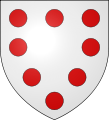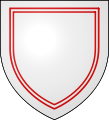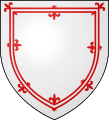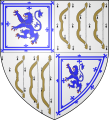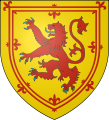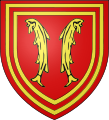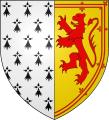- Orle (heraldry)
-
In heraldry, an orle is a subordinary consisting of a narrow band occupying the inward half of where a bordure would be, following the exact outline of the shield but within it, showing the field between the outer edge of the orle and the edge of the shield.
An orle can sometimes be confused with an inescutcheon or escutcheon voided (a smaller shield with a shield-shaped hole), or with a patch of the field left over between a bordure and an inescutcheon.
Orles may varied by any of the lines of variation.
Discrete charges arranged in the position of an orle are described as in orle or as "an orle of".
-
The arms of Dervorguilla of Galloway and her husband John de Balliol; the latter's orle is dimidiated
Tressure
A Tressure is a subordinary that can be regarded as a diminutive of an orle. John Woodward is of the opinion that a plain tressure is a diminutive of the orle, and is depicted half its thickness. A tressure is normally an ' orle gemel', i.e. an orle divided into two narrow ones set closely together, one inside the other. A. C. Fox-Davies argues that a tressure is by necessity double, otherwise it would be an orle. However, examples exist of coats of arms with a single tressure, as in the arms of Edward Lawrence.
Plain tressures are rare. It is much more common to see tressures flory-counter-flory, especially in Scottish heraldry, where many coats of arms derive from the Royal Coat of Arms. As a result the double tressure flory-counter-flory is often referred to as 'the royal tressure'.
When a tressure is impaled, it is supposed to follow the same rule as the bordure, and not to be continued on the side of the impalement, but several exceptions may be found.
-
Example of a double tressure impaled, the arms of Isabella of Scotland.
References
- A C Fox-Davies A Complete Guide to Heraldry (revised by J P Brooke-Little, Richmond Herald), Thomas Nelson and Sons, London 1969
Categories:- Heraldic ordinaries
Wikimedia Foundation. 2010.




